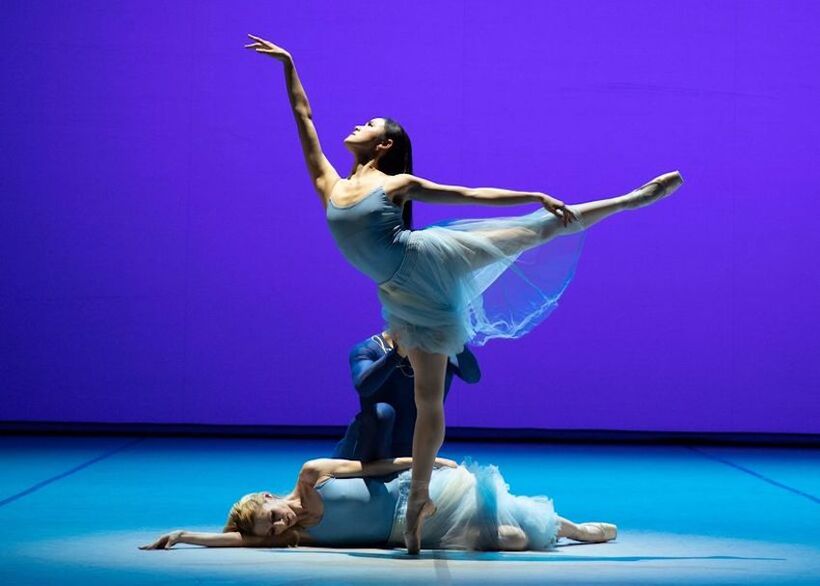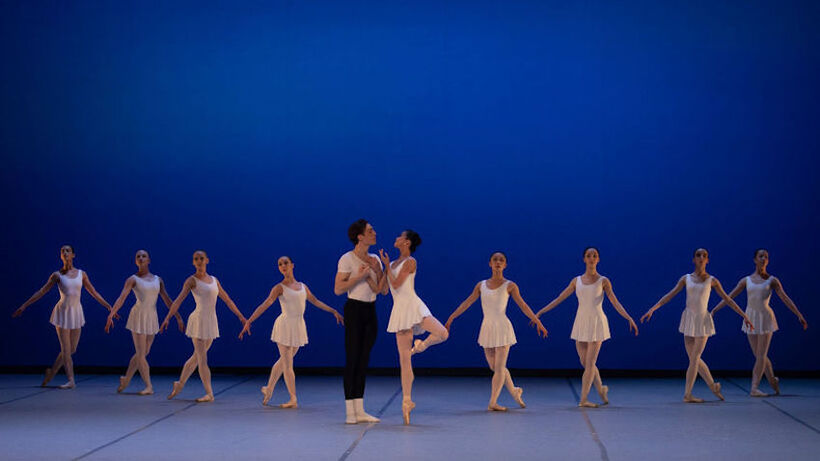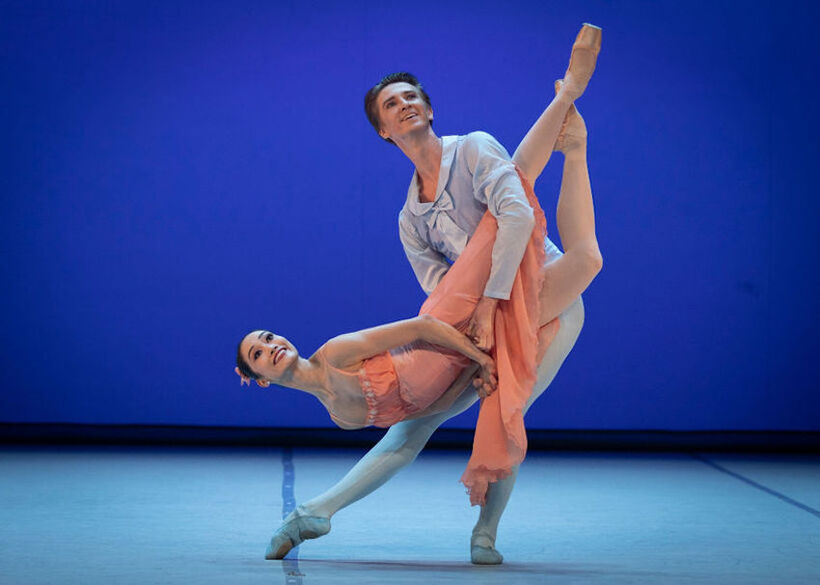Balanchine quadruple bill in Brno
In the West, especially in the United States, programmes made entirely of George Balanchine's works are very common. In the Czech Republic, however, until this year no ballet company had ever staged a similarly composed evening. In the current 2022/2023 season, our two largest ballet companies - the Czech National Ballet in Prague and the Ballet of the Brno National Theatre - were to battle for the first-ever all-Balanchine evening. The Prague premiere of Who Cares? programme was cancelled, and the first all-Balanchine programme was staged at the Brno National Theatre.
The work of George Balanchine is not unknown in the Czech Republic. His work, Divertimento no. 15, was first performed by the Czech National Ballet as part of the triple bill Amerikana in 1995. Seven years later, the same company brought Tarantella and Who Cares? to a sequel Amerikana II, and in 2012, still in Prague, came Amerikana III and with it Theme and Variations. Most recently, Balanchine's Serenade was part of the Czech National Ballet's triple bill Timeless (2017). The same choreography was first performed in the Czech Republic by the Ballet of the Brno National Theatre just two years earlier as part of the Made in USA programme. This time it returned to it and opened the current programme with the simple title Balanchine.
Set to Tchaikovsky's Serenade for Strings in C, this 1935 work was made for students at the newly founded School of American Ballet and in 30 minutes showcases Balanchine's finely tuned neoclassical American ballet technique. The girls, in light blue, simple costumes with longer tulle skirts, float through the space in precise lines and geometric shapes; the choreographer plays with their interweaving and canons, intuitively following the dynamics of the music, which translates into the constant movement of the entire choreography, from which the solo roles then emerge. The Brno company faced bravely all the Balanchine challenges, even though the leitmotif of the evening was the occasional difficulties with spacing and evenly placed dancers. A far more pressing problem for Serenade, however, was one of the central soloists, principal dancer Klaudia Radačovská. Her performance was simply weak in all areas; she lacked even basic musicality, which is a crucial problem in Balanchine's work; she lacked the ability and courage to increase her movement and go "over the edge" to give the dance a sense of infinity and constant flight; her steps lacked finesse and precision; and her upper-body work was somewhat wooden at best. I don't know if it was a weak day for her, a return to the stage after injury or illness, but the overall impression of the piece was unfortunately one of great dissatisfaction.
The Brno programme gives space primarily to Balanchine's pure, choreographically clearly understandable pieces. The Serenade is complemented by the Concerto Barocco to Bach's Concerto for Two Violins in D minor, a ballet dating back to the 1940s, which is characterised by an even simpler costume than the Serenade. A plain white leotard with a short skirt that draws attention to the long, elongated lines of the ballerinas' legs, as does the combination of white t-shirt and black leggings with white socks and shoes of the male dancer. The choreography carefully follows the structure of the baroque concerto, and while not literal paintings of the musical parts, it emphasizes the legibility of the musical piece. The focus is on the two female soloists and one man alongside a small female corps de ballet, but as is largely customary with Balanchine, the man acts as a support for the female dancers rather than a stand-alone, independent entity in his own right. Of the ballerinas, Chanell Cabrera, representing the 2nd violin, was particularly striking, her dynamics, natural musicality, energy and charisma, with which she was able to fill the slightest movement, perfectly overshadowing Eriko Wakizono as the embodiment of the 1st violin. In Wakizono's duet with Robert Hyland, she blossomed much more and displayed the delicacy and length of her legs and arms, yet in contrast to Cabrera, she lacked greater attention to the small accents of the music and therefore the movements.
In the last part of the evening, the ear-pleasing Baroque was replaced by the experimental expressionism of Anton Webern, a major figure of the revolutionary 2nd Viennese School (other names include Arnold Schönberg, Webern's mentor, and Alban Berg). The work of this artistic group of composers, who brought elements of atonality and dodecaphony (i.e. the twelve-tone scale) to European classical music, was one of the key influences on the music of the entire 20th century, as well as avant-garde and serialism composers such as Pierre Boulez, György Ligeti, Olivier Messiaen and even John Cage. It presented a completely new way of thinking about musical composition, turning to sophisticated mathematical principles and challenging composers and performers as well as audiences, as it was largely in direct opposition to everything that the European ear in particular had known and understood as harmonious, i.e. aesthetically pleasing, up to that time. It is not easy to come to an understanding or acceptance of this music, personally, I see this development as essential, I can understand some of the principles and forms to a certain extent and on this basis, I am able to appreciate it rationally, but since I expect emotions from the art of any kind, I usually do not get them from these pieces, probably because I lack the ability to read them.
The 1959 ballet Episodes, which originally consisted of two parts, one of which was created alongside Balanchine by Martha Graham, cannot be denied the choreographer's deep understanding of the compositions performed, perfectly reflecting Balanchine's background in music and the influence of his father, a composer. The choreography makes it much easier to perceive the structure of the musical compositions and Balanchine's famous quote "See the music, hear the dance" comes to full fruition here. The problem is that in my eyes the action on stage becomes a simple gymnastics routine. At a very high level, full of clear, broken lines, an experiment which in the movement element still takes its cues from the understandable principles of classical dance technique, but bent to new angles and placed in the new context of atonal music free of graspable harmony or melodic lines (the melody only comes in the final movement, when Webern uses the six-voice fugue Ricercar a 6 by J. S. Bach). One must, to a large extent, necessarily admire the focused and meticulous performance of all the dancers (the duo of Se Hyun An and Robert Hyland in the last fugue and Anna Yeh and Joao Gomes in the preceding concert were particularly impressive), but as a final piece of the whole quadruple bill the choice of Episodes seems damn risqué.
Tschaikovsky Pas de Deux is much less of a risk musically but makes up for it with the challenging dance technique. This world-famous duet was created by Balanchine in 1960 to the music of the Black Pas de Deux from Swan Lake, which P. I. Tchaikovsky wrote in 1877 for Anna Sobechanskaya, who did not like his original composition and wanted to add one by Ludwig Minkus' to the score instead, which Tchaikovsky refused. Balanchine's pas de deux became a phenomenon during the 20th century, which almost no ballet gala anywhere in the world can do without. Tschaikovsky Pas de Deux first appeared in the repertoire of the Czech ballet company thanks to the mixed programme Balletomania of the Czech National Ballet. In Brno, where the pas de deux formed the middle part of the programme together with the Concerto Barocco, the opening night was graced by world-famous guest artists, adding to the evening's international glamour and status as the event of the season. The Janáček Theatre hosted a dance couple from The Royal Ballet and regular guests in Brno Fumi Kaneko and Vadim Muntagirov, who did exactly what was expected of them (and then some). Confidence, rock-solid technique, perfect control and immense ease in even the most difficult elements. Kaneko handled the demands of the fast, sweeping American style with ease (which is in some ways a counter-task for dancers of the English school), while Muntagirov still loses none of his admirable elevation and boyish enthusiasm that radiates from him on stage and makes even the triple to quadruple pirouettes à la seconde look like the most natural thing in the world.
The premiere of the first all-Balanchine evening in Brno was definitely a success (except for the hesitation in Serenade). Sometimes the feeling of an absolute flight into space and a full understanding of Balanchine's musicality was still lacking, but these are little things, which can be expected to be met with further performances. True, I personally missed the typical Balanchine port de bras and the specific posture of hands and fingers, which is familiarly called "claws" in English, but let the Brno dancers be forgiven.
Written from the premiere of 5 May 2023, Janáčkovo theatre, Brno.
Balanchine
Serenade
Choreography: George Balanchine
Music: Petr Iljič Čajkovskij
Costumes: Barbara Karinska
Staging: Nanette Glushak
Tschaikovsky Pas de Deux
Choreography: George Balanchine
Music: Petr Iljič Čajkovskij
Costumes: Barbara Karinska
Staging: Diana White
Concerto Barocco
Choreography: George Balanchine
Music: Johann Sebastian Bach
Staging: Nanette Glushak
Violin solo: Jan Rybka, Dennis Schneiderka
Episodes
Choreography: George Balanchine
Music: Anton Webern
Costumes: Barbara Karinska
Staging: Diana White






